.
Ahh, starting the school year! A time for both excitement and nervousness, right? I actually enjoy going in and setting up my classroom, shining up my bookshelves, and decorating with posters and displays appealing to my 7th and 8th graders.
Then I take that first peek at my new class lists. Reality sets in. Time to bring the A game. Read on and I will share with you 5 key strategies to set yourself up for a solid start to your school year.
-
Plan Out the Seating –
Whether you have all desks or a more flexible arrangement, seating students strategically to best address their learning needs makes sense to me. Therefore, I have always used assigned seats for my middle school kids. On the first day of school, however, students always come in asking, “Where do we sit?” I tell them, “Go ahead and take a seat anywhere today. I’ll have a seating chart tomorrow.” Of course, they always look delighted and sit next to their friends. Little do the students know, I use this first day free-seating arrangement as my opportunity to observe their behaviors seated near classmates of their choice. Now I better know which students I might need to separate.
Early in the period, I pass out a quiet task (usually a survey). While students are completing the task, I go around and quickly record their names on the “today only” seating chart. I just read their name off the top of the paper they are working on. Then, during the rest of the period, based on the behaviors I observe, I can make short notes on that seating chart that will guide me when I make the “real” seating chart. I might write T for talkative, P for participates, R for respectful, MA for move apart, arrows for moving students around, etc. From this, I then create a new seating chart for the very next class. Now I have my more talkative students near respectful role models.
-
Be Ready to Set Your Tone –
When new students come into class, they are “sizing us up” to determine the type of teacher they will have. It’s important to be ready to display the teacher image you plan to uphold throughout the year. For example, you’ll probably want to share some info about your personal life on the first day of school, but decide ahead of time how much. Think about how you want to build your rapport with students. Will it mean conversing about your life and theirs at the beginning or end of each period? Or will you greet your students as they come into class and then have them settle right into their work when the bell rings? Everyone has their own style, so there’s not a right or wrong way. But when starting the school year, we all should be prepared to make that great “first impression.” Then we can build on it throughout the year.
-
Start into the “Real Work” ASAP –
It’s great to start off with an icebreaker to build community in your classroom. Students will feel valued and welcome. If you can, join in and be part of the activity so students can learn more about you as well! I like to use an icebreaker on the first day, but on Day 2 we get right into the ELA curriculum. As 7th and 8th graders, most of my students already know each other, and I don’t know about you, but I feel like I have so much to teach! My students need to get comfortable with my teaching style, and I’m eager to assess their learning needs. So why wait?
I love starting out my curriculum with a Selfie Free Verse Poem writing lesson. It allows me to learn a lot more about each of my students and dive right into some descriptive writing instruction. By jumping right into a writing process activity, your students will understand that drafting, revising, and editing are valuable steps they will use as writers in your classroom. (And, the Selfie poems give me that awesome display I need for Parent Night!)
By the way, my first-day-of-school Icebreaker is fast and easy. Here it is: After students have taken the survey, I’ve explained areas of the classroom, and we’ve looked at Class Expectations (it’s fun to use some memes here), I say, “Okay, now everybody stand up.” Meanwhile, I have prepared a list of sentences that could apply to one or more of my students. Many of the sentences have to do with their experiences over the summer and a few relate to their ELA knowledge. I say “I’m going to read a sentence. If you could answer YES, remain standing. If you would have to answer NO, sit down.” So students are standing up and sitting down, based on their responses, and the ones who are standing (with the yes answers) are asked to share. After several have shared, I read the next sentence. Students seems to enjoy both the movement and sharing about their experiences this way.
If you’d like a free copy of the Icebreaker Sentences, you can grab it here. Of course, add some more sentences of your own! For an editable version in Google Drive, click: ICEBREAKER-EDITABLE.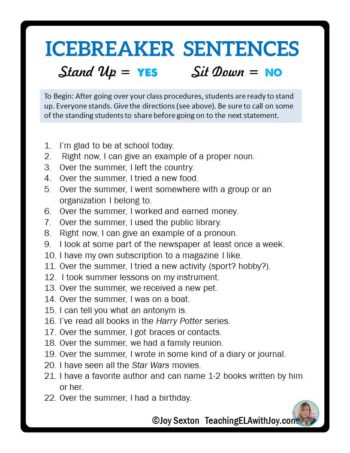
-
Show That You’re Organized –
Organization is a huge key to starting the school year off right. Make sure you have a system for managing materials for however many preps you have to teach. Your students may not notice that you are organized, but they will definitely notice your stress and frustration if you aren’t ! Make sure that you set up an area for
- materials that have been copied for at least a week ahead that you can grab and use
- papers to be stored for each class as soon as they’re handed in
- papers for each class that you’ve finished grading
- student make-up work
I have a literature organizer with slots that sits next to my desk. The whole first vertical row of slots are for current ready-to-use handouts. For the middle row, I label the slots by class. That’s so I can toss the papers in when I collect an assignment. I put them in 2-pocket folders. For the back row of slots, I also label them by class and I place graded work in there. Then at the front of my room I use wire baskets. One holds the current day’s handouts and the other holds several past handouts. I have a separate basket that I keep on a side table next to my desk that holds all my materials for my Advanced class. I keep the make-up work on a stand in the back corner of the room, marked with name and class period.
I’m sure that my organizational system is not the most optimal or high tech, but it works for me. And that’s exactly what you’ll need–a system that works for you.
Speaking of tech, then there’s your Smart Board stuff, YouTube videos, Google images, Bell Ringer, laptop cart (unless your classroom is 1:1), and whatever else needs to be ready at your fingertips. Get it all set up before you leave school each day. A morning “scramble” (especially in front of your students) is something to definitely prevent!
-
Begin Class with Predictable Routines –
One great thing about starting class with predictable routines is that wonderful quiet once the bell rings! If you start with a writing prompt, students know to grab their journals (or Chromebooks), log in the topic, and write. For independent reading days, novels are out, and class is on a roll! If you teach with Bell Ringers, you project the slide, dim a couple lights, and students are engaged in learning. I love it! When the designated time is up, students are settled in and primed to move on to the unit work.
You’ll want to familiarize students with your expectations for class start-up and begin these routines right away. By doing so, you’ll be setting students up for success. It might take them a while to get into the swing of your routines (after all, how many other classes do they have?), but the payoff is huge. You’ll even be warding off some potential behavior issues students sometimes bring into class.
So that’s it! Thanks for letting me share with you some strategies for starting the school year and rockin’ it. May it be the BEST EVER.
Check out these engaging beginning-of-the-year resources:

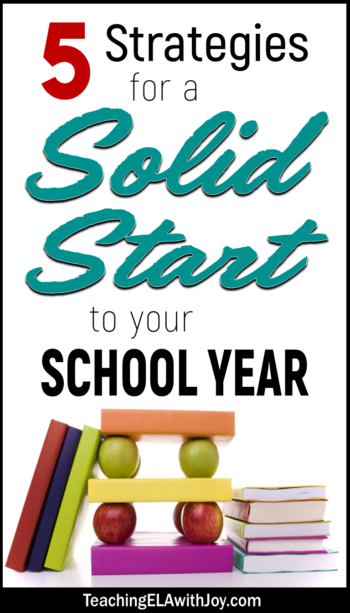
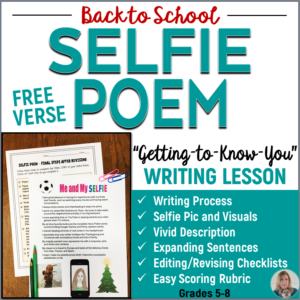
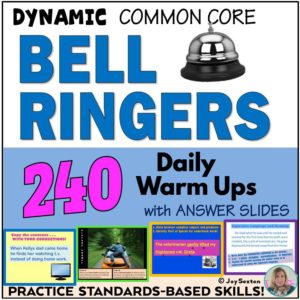
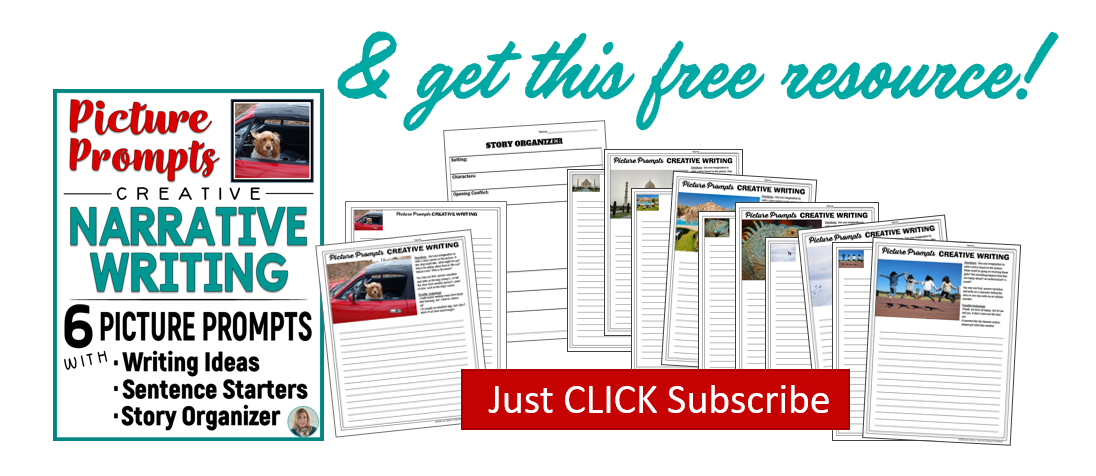


Planning a routine will really help in establishing classroom rules and managing the class. This will also help in figuring out the dynamics of the students.